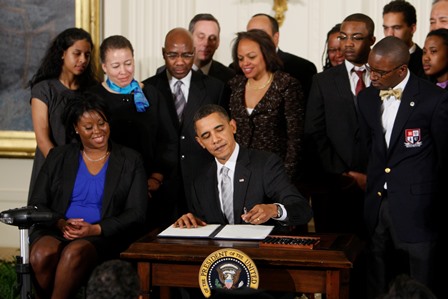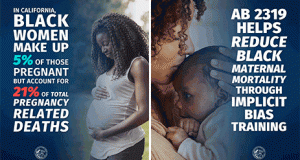
President Barack Obama signs an executive order for the White House Initiative on Historically Black Colleges and Universities, Friday, Feb. 26, 2010, in the East Room of the White House in Washington. (AP Photo/Charles Dharapak)
By Gina Chirichigno and Philip Tegeler
America’s Wire Writers Group
Addressing a crowded room of magnet school educators and supporters last week, Acting U.S. Secretary of Education John King explained his personal commitment to school diversity and the importance of reducing racial isolation in schools.
“I was a kid who benefited from intentional school diversity, and I’m a parent who prioritizes that in how I think about the education of my children,” he said, describing his experiences at two intentionally diverse schools in New York City (P.S. 276 in Canarsie and Mark Twain Junior High in Coney Island). “Teachers at those two schools saved my life,” he declared. “They are the reason I am standing here today.”
King’s children both attend diverse public schools in Montgomery County, MD, which, as he noted, has been working to implement intentional strategies to integrate both housing and education for decades. Now, he wants to encourage other communities to adopt that approach.
Thanks in large part to Secretary King, the Obama administration has now made a meaningful commitment to reducing racial and socioeconomic isolation in our nation’s schools, by proposing a $120 million request in the 2017 budget to fund the “Stronger Together” initiative. The new competitive funding program would offer planning and implementation grants for voluntary, community-developed socioeconomic integration plans. The proposed 2017 budget also includes an increase in funding for the Magnet Schools Assistance program, another school integration program.
The Stronger Together program would supply four implementation grants (averaging $25 million each) for up to five years to support communities currently implementing strategies to improve racial and socioeconomic diversity. Stronger Together would also award 10 one-year planning grants (averaging $2 million each) to help support activities such as: fostering family and community engagement; assessing economic stratification; evaluating the adequacy of transportation infrastructure; increasing capacity for data collection, etc.
As members of the National Coalition on School Diversity (www.school-diversity.org), we have been advocating for a clear, courageous investment in integration from the beginning of President Obama’s administration. Our country is long overdue for government-supported innovation in school integration. And, while Congress is unlikely to pass the 2017 budget in its current form, we are confident that the commitment to school diversity will remain in some form in the final budget.
Studies consistently show that school integration by race and socioeconomic status is strongly associated with a range of short and long term benefits for all racial groups. As a whole, however, our nation’s schools remain overwhelmingly isolated by race and class, even as our country becomes increasingly diverse. Such isolation is not benign; rather, it fuels a vicious cycle of structural educational inequity and, too, strips us of opportunities to build community across lines of difference.
Justice Thurgood Marshall’s observation that, “Unless our children begin to learn together, there is little hope that our people will ever learn to live together,” is now supported by a strong research base demonstrating the benefits of racial integration—not just for student achievement, but also for reducing interracial prejudice and strengthening relations between racial groups. This research should encourage us all to take integration strategies more seriously.
We are particularly pleased to see such a strong emphasis on community engagement and involvement in the Stronger Together program—voluntary school integration efforts are most effective when communities come together to develop the political will to co-create and implement strategies that respond to their unique context. We can readily point to examples of remarkable community-led integration efforts in progress, in cities such as Hartford, CT; Richmond, VA; and New York, NY. But the lack of federal, state, local, and foundation support for this work makes it extremely challenging to initiate and sustain, even when there is strong interest. Programs like Stronger Together would help change that.
Stronger Together would afford communities across the country the opportunity to come together and co-create learning environments where, truly, every student can succeed. It is now up to people on the ground—educators, parents, students, and community leaders—to ensure that the administration’s newly-ignited commitment to school integration receives the funding we believe it deserves.
Gina Chirichigno is outreach coordinator for the National Coalition on School Diversity, www.school-diversity.org. You can reach her at gchirichigno@prrac.org.
Philip Tegeler is executive director of the Poverty and Race Research Action Council, www.prrac.org. You can reach him at ptegeler@prrac.org.
America’s Wire is an independent, nonprofit news service run by the Maynard Institute for Journalism Education. Our stories can be republished free of charge by newspapers, websites and other media sources. For more information, visit www.americaswire.org or contact Michael K. Frisby at mike@frisbyassociates.com.
 Westside Story Newspaper – Online The News of The Empire – Sharing the Quest for Excellence
Westside Story Newspaper – Online The News of The Empire – Sharing the Quest for Excellence



